外研版 选修八 Module 6 The Tang Poems Reading 课件(36张ppt)
文档属性
| 名称 | 外研版 选修八 Module 6 The Tang Poems Reading 课件(36张ppt) | 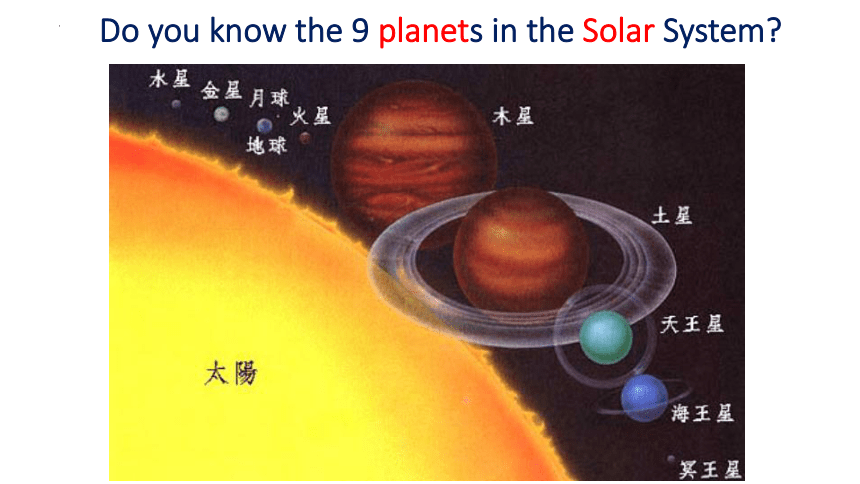 | |
| 格式 | pptx | ||
| 文件大小 | 5.0MB | ||
| 资源类型 | 教案 | ||
| 版本资源 | 外研版 | ||
| 科目 | 英语 | ||
| 更新时间 | 2022-12-10 10:12:46 | ||
图片预览

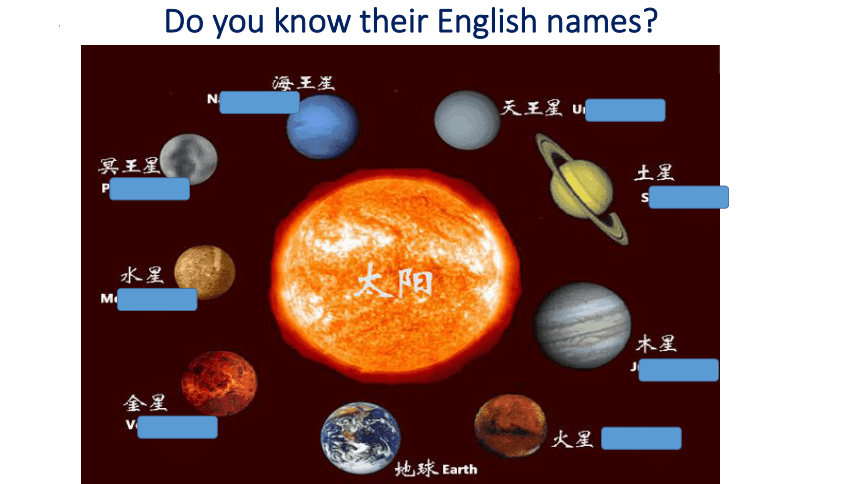

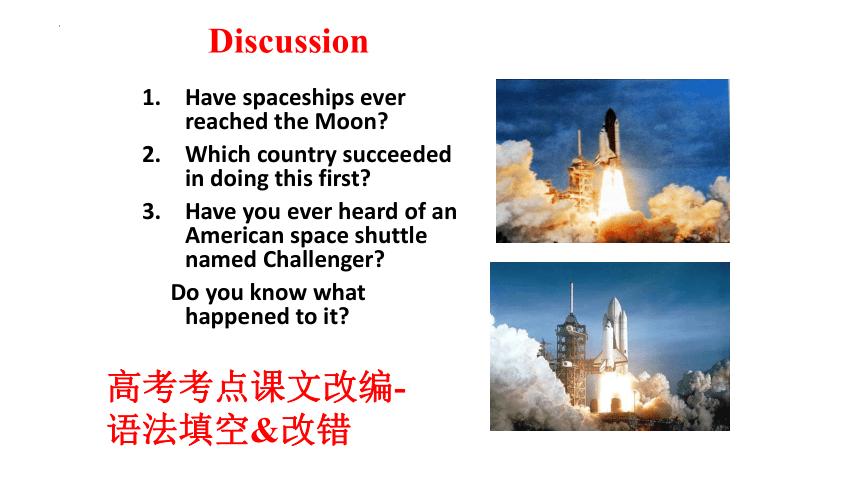
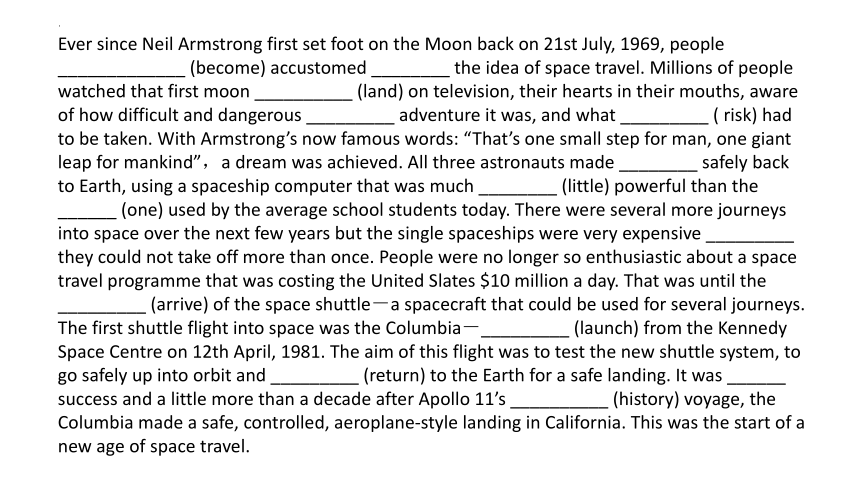
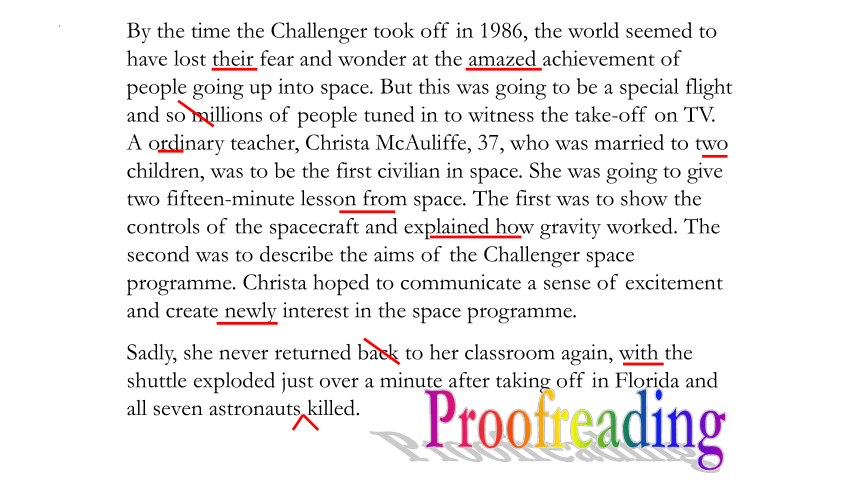
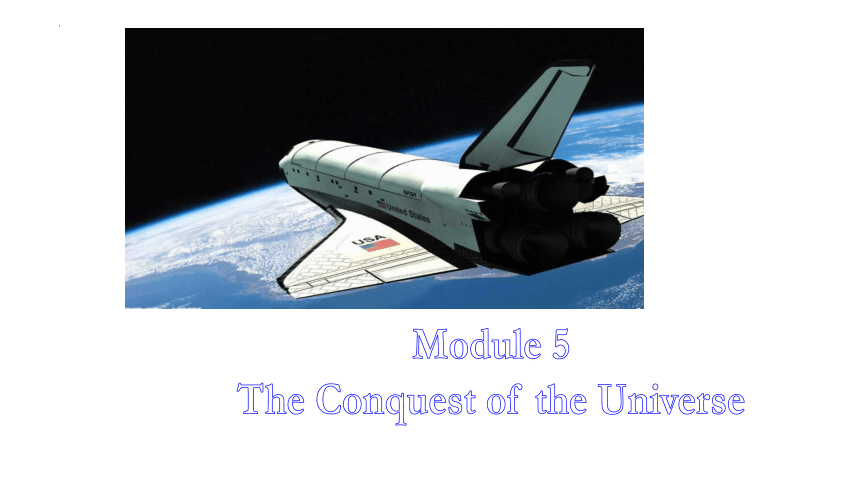
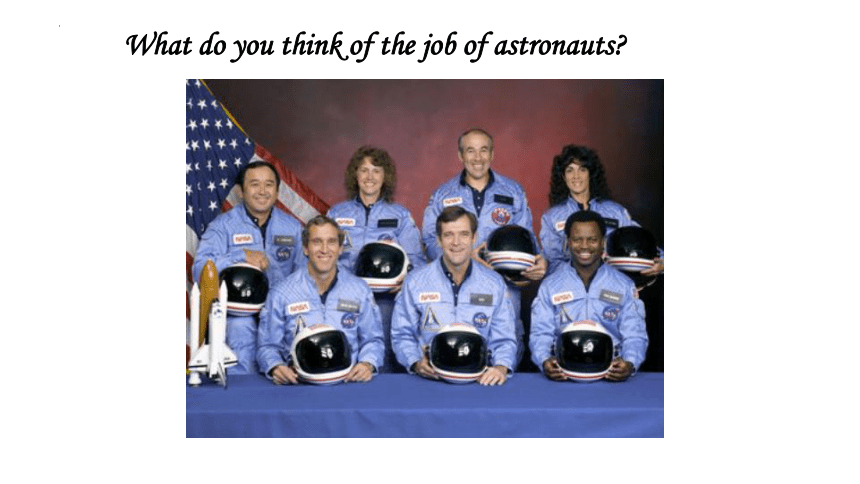
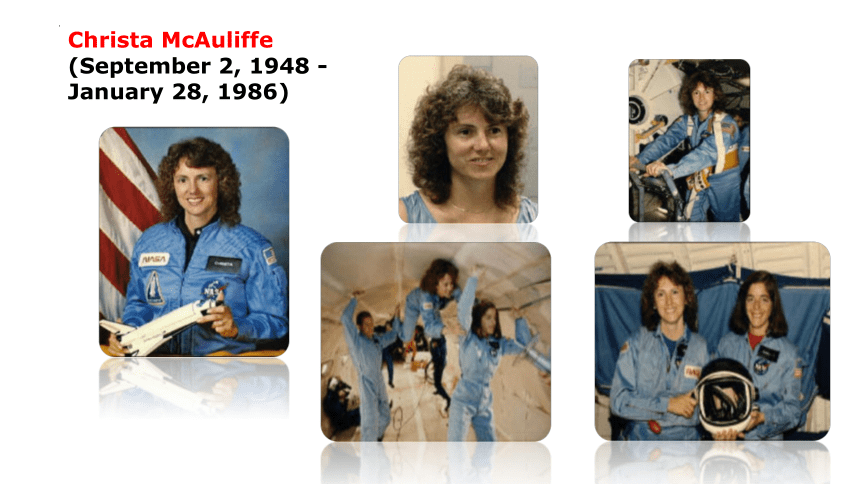
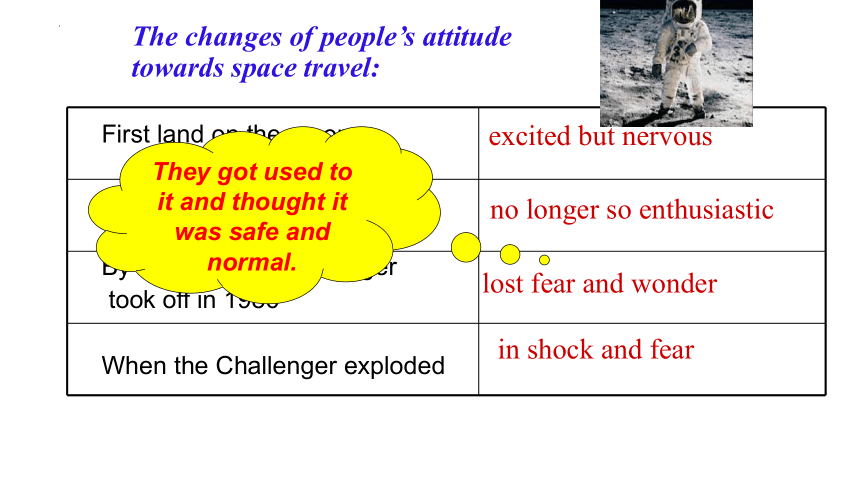

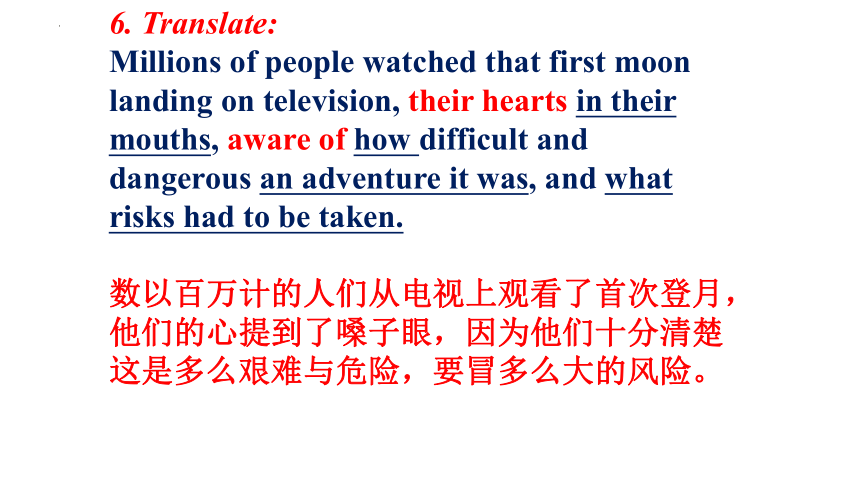
文档简介
(共36张PPT)
Do you know the 9 planets in the Solar System
Do you know their English names
Do you want to explore the universe
Have spaceships ever reached the Moon
Which country succeeded in doing this first
Have you ever heard of an American space shuttle named Challenger
Do you know what happened to it
Discussion
高考考点课文改编-
语法填空&改错
Ever since Neil Armstrong first set foot on the Moon back on 21st July, 1969, people _____________ (become) accustomed ________ the idea of space travel. Millions of people watched that first moon __________ (land) on television, their hearts in their mouths, aware of how difficult and dangerous _________ adventure it was, and what _________ ( risk) had to be taken. With Armstrong’s now famous words: “That’s one small step for man, one giant leap for mankind”,a dream was achieved. All three astronauts made ________ safely back to Earth, using a spaceship computer that was much ________ (little) powerful than the ______ (one) used by the average school students today. There were several more journeys into space over the next few years but the single spaceships were very expensive _________ they could not take off more than once. People were no longer so enthusiastic about a space travel programme that was costing the United Slates $10 million a day. That was until the _________ (arrive) of the space shuttle-a spacecraft that could be used for several journeys. The first shuttle flight into space was the Columbia-_________ (launch) from the Kennedy Space Centre on 12th April, 1981. The aim of this flight was to test the new shuttle system, to go safely up into orbit and _________ (return) to the Earth for a safe landing. It was ______ success and a little more than a decade after Apollo 11’s __________ (history) voyage, the Columbia made a safe, controlled, aeroplane-style landing in California. This was the start of a new age of space travel.
By the time the Challenger took off in 1986, the world seemed to have lost their fear and wonder at the amazed achievement of people going up into space. But this was going to be a special flight and so millions of people tuned in to witness the take-off on TV. A ordinary teacher, Christa McAuliffe, 37, who was married to two children, was to be the first civilian in space. She was going to give two fifteen-minute lesson from space. The first was to show the controls of the spacecraft and explained how gravity worked. The second was to describe the aims of the Challenger space programme. Christa hoped to communicate a sense of excitement and create newly interest in the space programme.
Sadly, she never returned back to her classroom again, with the shuttle exploded just over a minute after taking off in Florida and all seven astronauts killed.
Proofreading
Module 5
The Conquest of the Universe
What do you think of the job of astronauts
Christa McAuliffe (September 2, 1948 - January 28, 1986)
The changes of people’s attitude towards space travel:
First land on the moon
In the next few years
By the time the Challenger
took off in 1986
When the Challenger exploded
in shock and fear
excited but nervous
no longer so enthusiastic
lost fear and wonder
They got used to it and thought it was safe and normal.
Read Part 1 and answer the questions.
1.Why does the writer call the passage Space: the Frontier
2. P2 L7 That was until the arrival of the space shuttle– a spacecraft that could be used for several journeys. That refers to __________.
3. What was different about the space shuttle
4. Why did people want to watch the Challenger take off
5. What did the Challenger disaster teach the world
Because there are no new places left on Earth for humans
to discover but we have not yet explored space.
The fact that people were no longer so enthusiastic about a space travel programme.
The space shuttle could be used many times.
Because it was a new spacecraft and it had a teacher on
board as well as astronauts.
Space flight was still dangerous
6. Translate:
Millions of people watched that first moon landing on television, their hearts in their mouths, aware of how difficult and dangerous an adventure it was, and what risks had to be taken.
数以百万计的人们从电视上观看了首次登月,他们的心提到了嗓子眼,因为他们十分清楚这是多么艰难与危险,要冒多么大的风险。
Read Part 2 of the passage. Work in pairs and describe :
1.How did the boy feel before the take-off
2. What happened when the Challenger exploded
3. How did he feel after witnessing the accident on TV
4. What did he think about space travel a few weeks later .
He was very excited.
A red and orange light appeared in the sky, followed by a
cloud of white smoke.
He was in a state of shock.
I was not so sure it was worth it at all.
He was not sure whether it was worth exploring space if
people were going to die.
space flight
the cost of money and human lives
Match the words in the box with their meanings.
accustomed assume civilian enthusiastic explore
mankind patience shuttle witness
1.to see something happen, for example an important
event, or a crime_________________
2.to think that something is true,even if you are not sure
________
3.a vehicle that goes to a place and comes back_________
4. an ordinary person who is not in the armed forces or
the police__________
5. To burst with a lot of force and loud noise_________
6. Very interested in something or excited by it____________
7.the ability to stay calm,especially when you have to wait
for something__________
8.all the people in the world_________
9.getting used to something_____________
witness
assume
shuttle
civilian
explode
enthusiastic
patience
mankind
accustomed
重点短语:
1)踏上
2)习惯于
3)非常紧张,提心吊胆
4)意识到
5)冒险干某事
6)实现梦想
7)对...充满热情
8)一次安全着陆
9)把...调到某台,收听收看
10)已婚并有两个孩子
重点短语:
1)set foot on
2)become accustomed to sth
3)their hearts in their mouths
4)be aware of
5)take risks to do sth
6)achieve one’s dream
7)be enthusiastic about
8)a safe landing
9)tune in
10)be married with two children
11)一种兴奋感
12)起飞
13)处在震惊中
14)和...一样没危险
15)处于震惊的状态
16)在海洋的底部
17)不管
18)先进的技术
19)在...起步阶段
20)上两节15分钟的课
11)a sense of excitement
12)take off
13)be in shock
14)no more dangerous than
15)in a state of shock
16)at the bottom of the ocean
17)in spite of
18)advanced technology
19)at the very beginning of …
20)give two fifteen-minute lessons
1. accustom vt. 使习惯于
accustom oneself to (doing) sth.
It took us a while to accustom ourselves to the teaching style of Miss Cai.
accustomed adj. usual/ habitual 惯常的;习惯的
He took his accustomed seat by the window.
be/get/ become/ grow accustomed to (doing) sth. 习惯于
My eyes slowly grew accustomed to the darkness.
I’ve become so accustomed to noise made by the passing planes.
Association:be /get/ become/ grow used to (doing) sth.
used to do sth./ be used to do sth.
2. make it = succeed in doing sth. 成功做成某事/ 到达某地
Having gone through great difficulties, the woman finally made it to the South Pole.
= …, the woman finally succeeded in reaching the South Pole.
When a candidate went through to the next round, the judge would say “Congratulations! You made it!”
在努力了三年之后, 他成功考取了清华.
After three years’ hard work, he made it to Tsinghua University.
3. assume vt. accept sth. as true when there is no proof
We must assume him to be innocent until he is proved guilty.
--- Sorry, sir. I assumed that …
--- Don’t assume!
It is generally assumed that…
It is generally assumed that stress is caused by too much work.
assumption n.
_______________________ (普遍认为) hard work leads to great success. So we all ________________(觉得他会) successful. But __________ (假设) he isn’t that lucky, what shall we do to comfort him
假定,假设;以为
It is generally assumed that
assume he will be
assuming
We’ve never had a tragedy like this. And perhaps we’ve forgotten the courage it took for the crew of the shuttle. But they, the challenger seven, were aware of the dangers, but overcame them and did their jobs brilliantly. The future belongs to the brave. The challenger crew was pulling us into the future, and we’ll continue to follow them .
----By former president Reagan
p.57-exercise 1
1.Read and match
2.draw a timeline
Introduction---1 (P57-1)
Match the events with the dates
Yang Liwei becomes the first Chinese astronaut. He describes the experience as marvelous.
American Neil Armstrong becomes the first man to set foot on the moon. He describes the moment as “One small step for man, one giant leap for mankind”.
A 60-year-old American, Denis Tito, becomes the first space tourist. He spends eight days on board the Russian part of a joint USA-Russia space mission.
2003
1969
2001
Match the events with the dates
d) Seven American astronauts are killed just over a minute after taking off in Challenger. It is the biggest space disaster so far, and slows down the American space programme.
e) Russian Yuri Gagarin becomes the first man in space. It takes him just 108 minutes to go round the world.
f) The American Viking 1 mission lands on Mars and sends back good quality photos.
1986
1961
1976
Match the events with the dates
g) Pioneer 10 becomes the first spaceship to fly past Jupiter. It is headed for the red star Aldebaran, which it will reach in two million years’ time.
h) Nearly seven years after being launched, the Cassini space probe reaches Saturn. It sends beautiful images of Saturn’s rings back to Earth.
1973
2005
1960年2月19日,中国自行设计制造的试验型液体燃料探空火箭首次发射成功。
★里程碑之一【青铜时代】:
1970年4月24日21时31分,中国“东方红”一号飞向太空。这是中国发射的第一颗人造卫星。
1975年11月26日,中国首颗返回式卫星发射成功,3天后顺利返回,中国成为世界上第三个掌握卫星返回技术的国家
1985年10月长征火箭开始走向国际市场
★里程碑之二【白银时代】:
1987年8月,中国返回式卫星为法国搭载试验装置。这是中国打入世界航天市场的首次尝试。
1999年11月20日,中国第一艘无人试验飞船“神舟”一号试验飞船在酒泉起飞,21小时后在内蒙古中部回收场成功着陆。
2001年1月10日1时0分,中国自行研制的“神舟”二号无人飞船在酒泉卫星发射中心发射升空。
2002年3月25日,“神舟”三号在酒泉卫星发射中心成功升入太空。4月1日,“神舟”三号成功降落于内蒙古中部地区
2002年12月30日至2003年1月5日,神舟四号无人飞船在零下20多摄氏度的严寒中成功发射,并在飞行7天后平安返回
★里程碑之三【黄金时代】:
2003年10月15日,神舟五号载人飞船升空;2005年10月12日,神舟六号搭载两名航天员升空。
★里程碑之四【探月时代】:
2007年10月24日18时05分,搭载着我国首颗探月卫星嫦娥一号的长征三号甲运载火箭在西昌卫星发射中心三号塔架点火成功发射。
The time line of Chinese space exploration
天宫一号、神舟八号对接
天宫一号于2011年9月发射升空,此后分别与神舟八号、神舟九号、神舟十号3艘飞船6次交会对接,成为中国首个“太空之家”。它的设计寿命原本只有两年,但却凭借出色表现,超期服役了两年半,超寿命工作了1000多天。
2016年4月6日1时38分,我国首颗微重力科学实验卫星——实践十号返回式科学实验卫星,在酒泉卫星发射中心由长征二号丁运载火箭发射升空,进入预定轨道。是我国空间科学先导专项首批科学实验卫星中唯一的返回式卫星,将利用太空中微重力等特殊环境完成19项科学实验,涉及微重力流体物理、微重力燃烧、空间材料科学、空间辐射效应、重力生物效应、空间生物技术六大领域。
2016年8月16日1时40分,我国在酒泉卫星发射中心用长征二号丁运载火箭成功将世界首颗量子科学实验卫星(简称“量子卫星”)发射升空。此次发射任务的圆满成功,标志着我国空间科学研究又迈出重要一步。这将使我国在世界上首次实现卫星和地面之间的量子通信,构建天地一体化的量子保密通信与科学实验体系。
2016年9月15日22时04分09秒,天宫二号空间实验室在酒泉卫星发射中心发射成功。2016年10月17日7时30分,神舟十一号载人飞船在酒泉卫星发射中心点火升空。2016年10月19日3时31分,神舟十一号飞船与天宫二号自动交会对接成功。
2016年9月25日被誉为“中国天眼”的500米口径球面射电望远镜(FAST),在贵州省黔南州平塘县大窝凼竣工落成。
FAST是具有中国自主知识产权、世界最大单口径、最灵敏的射电望远镜。
2016年9月,FAST建成并开始接收来自宇宙深处的电磁波,进入试运行、调试阶段。一年来,FAST不知疲倦地扫描巡天,敏锐地捕捉各类信号,取得振奋人心的发现。2017年10月10日,FAST团队在京举行发布会表示,“中国天眼”探测到优质脉冲星候选体达数十个,其中目前已通过系统认证的脉冲星达6颗。
2017年04月20日,我国首艘货运飞船天舟一号,在我国文昌航天发射场发射成功。天舟一号具有与天宫二号空间实验室交会对接、实施推进剂在轨补加、开展空间科学实验和技术试验等功能。这是我国载人航天工程“三步走”发展战略第二步的收官之作,标志着我国即将开启空间站时代。
2017年11月5日19时45分,我国在西昌卫星发射中心用长征三号乙运载火箭,成功发射两颗北斗三号全球组网卫星。这是北斗三号卫星的首次发射,标志着中国北斗卫星导航系统步入全球组网新时代。
2017年11月27日,暗物质粒子探测卫星“悟空”腾空700多天后,暗物质卫星团队宣布:“悟空”获得了目前国际上最精确的TeV电子宇宙射线能谱,并首次直接测量到了该能谱在1TeV(1万亿电子伏特)处的拐折。这一疑似暗物质的踪迹,是近年来科学家离暗物质最近的一次重大发现,将打开人类观测宇宙的一扇新窗口。
2018年共发射火箭38枚,发射次数首次荣登世界第一。另外,嫦娥四号、北斗组网卫星的发射都取得了成功。
北京时间2018年12月8日凌晨2点24分,中国长征三号乙运载火箭在西昌卫星发射中心起飞,把“嫦娥四号”探测器送入地月转移轨道,踏上了奔赴月球背面的征程,经过27天飞行之后,
2019年年初着陆。
2019年12月,长征五号遥三运载火箭在中国文昌航天发射场完成技术区相关工作后,垂直转运至发射区。
2019年12月27日,长五遥三火箭成功发射。
推动中国探索更远深空能力建设;我国首次在海上实施运载火箭发射技术试验,成为世界上第三个掌握海上发射技术的国家;高分七号卫星发射入轨,初步实现高分辨率对地观测系统任务目标。此外,北斗卫星导航系统全年成功发射7次共10颗卫星,全球组网进入了冲刺期;快舟一号甲运载火箭在短短6个小时内,打破了同一发射工位和同一型号火箭发射时间间隔的最短纪录。
2020年,北斗全球卫星导航系统组网完成、
天问一号火星探测器发射成功、
新一代空间站整装待发、
嫦娥五号月球探测器实现月球表面取样返回
Do you know the 9 planets in the Solar System
Do you know their English names
Do you want to explore the universe
Have spaceships ever reached the Moon
Which country succeeded in doing this first
Have you ever heard of an American space shuttle named Challenger
Do you know what happened to it
Discussion
高考考点课文改编-
语法填空&改错
Ever since Neil Armstrong first set foot on the Moon back on 21st July, 1969, people _____________ (become) accustomed ________ the idea of space travel. Millions of people watched that first moon __________ (land) on television, their hearts in their mouths, aware of how difficult and dangerous _________ adventure it was, and what _________ ( risk) had to be taken. With Armstrong’s now famous words: “That’s one small step for man, one giant leap for mankind”,a dream was achieved. All three astronauts made ________ safely back to Earth, using a spaceship computer that was much ________ (little) powerful than the ______ (one) used by the average school students today. There were several more journeys into space over the next few years but the single spaceships were very expensive _________ they could not take off more than once. People were no longer so enthusiastic about a space travel programme that was costing the United Slates $10 million a day. That was until the _________ (arrive) of the space shuttle-a spacecraft that could be used for several journeys. The first shuttle flight into space was the Columbia-_________ (launch) from the Kennedy Space Centre on 12th April, 1981. The aim of this flight was to test the new shuttle system, to go safely up into orbit and _________ (return) to the Earth for a safe landing. It was ______ success and a little more than a decade after Apollo 11’s __________ (history) voyage, the Columbia made a safe, controlled, aeroplane-style landing in California. This was the start of a new age of space travel.
By the time the Challenger took off in 1986, the world seemed to have lost their fear and wonder at the amazed achievement of people going up into space. But this was going to be a special flight and so millions of people tuned in to witness the take-off on TV. A ordinary teacher, Christa McAuliffe, 37, who was married to two children, was to be the first civilian in space. She was going to give two fifteen-minute lesson from space. The first was to show the controls of the spacecraft and explained how gravity worked. The second was to describe the aims of the Challenger space programme. Christa hoped to communicate a sense of excitement and create newly interest in the space programme.
Sadly, she never returned back to her classroom again, with the shuttle exploded just over a minute after taking off in Florida and all seven astronauts killed.
Proofreading
Module 5
The Conquest of the Universe
What do you think of the job of astronauts
Christa McAuliffe (September 2, 1948 - January 28, 1986)
The changes of people’s attitude towards space travel:
First land on the moon
In the next few years
By the time the Challenger
took off in 1986
When the Challenger exploded
in shock and fear
excited but nervous
no longer so enthusiastic
lost fear and wonder
They got used to it and thought it was safe and normal.
Read Part 1 and answer the questions.
1.Why does the writer call the passage Space: the Frontier
2. P2 L7 That was until the arrival of the space shuttle– a spacecraft that could be used for several journeys. That refers to __________.
3. What was different about the space shuttle
4. Why did people want to watch the Challenger take off
5. What did the Challenger disaster teach the world
Because there are no new places left on Earth for humans
to discover but we have not yet explored space.
The fact that people were no longer so enthusiastic about a space travel programme.
The space shuttle could be used many times.
Because it was a new spacecraft and it had a teacher on
board as well as astronauts.
Space flight was still dangerous
6. Translate:
Millions of people watched that first moon landing on television, their hearts in their mouths, aware of how difficult and dangerous an adventure it was, and what risks had to be taken.
数以百万计的人们从电视上观看了首次登月,他们的心提到了嗓子眼,因为他们十分清楚这是多么艰难与危险,要冒多么大的风险。
Read Part 2 of the passage. Work in pairs and describe :
1.How did the boy feel before the take-off
2. What happened when the Challenger exploded
3. How did he feel after witnessing the accident on TV
4. What did he think about space travel a few weeks later .
He was very excited.
A red and orange light appeared in the sky, followed by a
cloud of white smoke.
He was in a state of shock.
I was not so sure it was worth it at all.
He was not sure whether it was worth exploring space if
people were going to die.
space flight
the cost of money and human lives
Match the words in the box with their meanings.
accustomed assume civilian enthusiastic explore
mankind patience shuttle witness
1.to see something happen, for example an important
event, or a crime_________________
2.to think that something is true,even if you are not sure
________
3.a vehicle that goes to a place and comes back_________
4. an ordinary person who is not in the armed forces or
the police__________
5. To burst with a lot of force and loud noise_________
6. Very interested in something or excited by it____________
7.the ability to stay calm,especially when you have to wait
for something__________
8.all the people in the world_________
9.getting used to something_____________
witness
assume
shuttle
civilian
explode
enthusiastic
patience
mankind
accustomed
重点短语:
1)踏上
2)习惯于
3)非常紧张,提心吊胆
4)意识到
5)冒险干某事
6)实现梦想
7)对...充满热情
8)一次安全着陆
9)把...调到某台,收听收看
10)已婚并有两个孩子
重点短语:
1)set foot on
2)become accustomed to sth
3)their hearts in their mouths
4)be aware of
5)take risks to do sth
6)achieve one’s dream
7)be enthusiastic about
8)a safe landing
9)tune in
10)be married with two children
11)一种兴奋感
12)起飞
13)处在震惊中
14)和...一样没危险
15)处于震惊的状态
16)在海洋的底部
17)不管
18)先进的技术
19)在...起步阶段
20)上两节15分钟的课
11)a sense of excitement
12)take off
13)be in shock
14)no more dangerous than
15)in a state of shock
16)at the bottom of the ocean
17)in spite of
18)advanced technology
19)at the very beginning of …
20)give two fifteen-minute lessons
1. accustom vt. 使习惯于
accustom oneself to (doing) sth.
It took us a while to accustom ourselves to the teaching style of Miss Cai.
accustomed adj. usual/ habitual 惯常的;习惯的
He took his accustomed seat by the window.
be/get/ become/ grow accustomed to (doing) sth. 习惯于
My eyes slowly grew accustomed to the darkness.
I’ve become so accustomed to noise made by the passing planes.
Association:be /get/ become/ grow used to (doing) sth.
used to do sth./ be used to do sth.
2. make it = succeed in doing sth. 成功做成某事/ 到达某地
Having gone through great difficulties, the woman finally made it to the South Pole.
= …, the woman finally succeeded in reaching the South Pole.
When a candidate went through to the next round, the judge would say “Congratulations! You made it!”
在努力了三年之后, 他成功考取了清华.
After three years’ hard work, he made it to Tsinghua University.
3. assume vt. accept sth. as true when there is no proof
We must assume him to be innocent until he is proved guilty.
--- Sorry, sir. I assumed that …
--- Don’t assume!
It is generally assumed that…
It is generally assumed that stress is caused by too much work.
assumption n.
_______________________ (普遍认为) hard work leads to great success. So we all ________________(觉得他会) successful. But __________ (假设) he isn’t that lucky, what shall we do to comfort him
假定,假设;以为
It is generally assumed that
assume he will be
assuming
We’ve never had a tragedy like this. And perhaps we’ve forgotten the courage it took for the crew of the shuttle. But they, the challenger seven, were aware of the dangers, but overcame them and did their jobs brilliantly. The future belongs to the brave. The challenger crew was pulling us into the future, and we’ll continue to follow them .
----By former president Reagan
p.57-exercise 1
1.Read and match
2.draw a timeline
Introduction---1 (P57-1)
Match the events with the dates
Yang Liwei becomes the first Chinese astronaut. He describes the experience as marvelous.
American Neil Armstrong becomes the first man to set foot on the moon. He describes the moment as “One small step for man, one giant leap for mankind”.
A 60-year-old American, Denis Tito, becomes the first space tourist. He spends eight days on board the Russian part of a joint USA-Russia space mission.
2003
1969
2001
Match the events with the dates
d) Seven American astronauts are killed just over a minute after taking off in Challenger. It is the biggest space disaster so far, and slows down the American space programme.
e) Russian Yuri Gagarin becomes the first man in space. It takes him just 108 minutes to go round the world.
f) The American Viking 1 mission lands on Mars and sends back good quality photos.
1986
1961
1976
Match the events with the dates
g) Pioneer 10 becomes the first spaceship to fly past Jupiter. It is headed for the red star Aldebaran, which it will reach in two million years’ time.
h) Nearly seven years after being launched, the Cassini space probe reaches Saturn. It sends beautiful images of Saturn’s rings back to Earth.
1973
2005
1960年2月19日,中国自行设计制造的试验型液体燃料探空火箭首次发射成功。
★里程碑之一【青铜时代】:
1970年4月24日21时31分,中国“东方红”一号飞向太空。这是中国发射的第一颗人造卫星。
1975年11月26日,中国首颗返回式卫星发射成功,3天后顺利返回,中国成为世界上第三个掌握卫星返回技术的国家
1985年10月长征火箭开始走向国际市场
★里程碑之二【白银时代】:
1987年8月,中国返回式卫星为法国搭载试验装置。这是中国打入世界航天市场的首次尝试。
1999年11月20日,中国第一艘无人试验飞船“神舟”一号试验飞船在酒泉起飞,21小时后在内蒙古中部回收场成功着陆。
2001年1月10日1时0分,中国自行研制的“神舟”二号无人飞船在酒泉卫星发射中心发射升空。
2002年3月25日,“神舟”三号在酒泉卫星发射中心成功升入太空。4月1日,“神舟”三号成功降落于内蒙古中部地区
2002年12月30日至2003年1月5日,神舟四号无人飞船在零下20多摄氏度的严寒中成功发射,并在飞行7天后平安返回
★里程碑之三【黄金时代】:
2003年10月15日,神舟五号载人飞船升空;2005年10月12日,神舟六号搭载两名航天员升空。
★里程碑之四【探月时代】:
2007年10月24日18时05分,搭载着我国首颗探月卫星嫦娥一号的长征三号甲运载火箭在西昌卫星发射中心三号塔架点火成功发射。
The time line of Chinese space exploration
天宫一号、神舟八号对接
天宫一号于2011年9月发射升空,此后分别与神舟八号、神舟九号、神舟十号3艘飞船6次交会对接,成为中国首个“太空之家”。它的设计寿命原本只有两年,但却凭借出色表现,超期服役了两年半,超寿命工作了1000多天。
2016年4月6日1时38分,我国首颗微重力科学实验卫星——实践十号返回式科学实验卫星,在酒泉卫星发射中心由长征二号丁运载火箭发射升空,进入预定轨道。是我国空间科学先导专项首批科学实验卫星中唯一的返回式卫星,将利用太空中微重力等特殊环境完成19项科学实验,涉及微重力流体物理、微重力燃烧、空间材料科学、空间辐射效应、重力生物效应、空间生物技术六大领域。
2016年8月16日1时40分,我国在酒泉卫星发射中心用长征二号丁运载火箭成功将世界首颗量子科学实验卫星(简称“量子卫星”)发射升空。此次发射任务的圆满成功,标志着我国空间科学研究又迈出重要一步。这将使我国在世界上首次实现卫星和地面之间的量子通信,构建天地一体化的量子保密通信与科学实验体系。
2016年9月15日22时04分09秒,天宫二号空间实验室在酒泉卫星发射中心发射成功。2016年10月17日7时30分,神舟十一号载人飞船在酒泉卫星发射中心点火升空。2016年10月19日3时31分,神舟十一号飞船与天宫二号自动交会对接成功。
2016年9月25日被誉为“中国天眼”的500米口径球面射电望远镜(FAST),在贵州省黔南州平塘县大窝凼竣工落成。
FAST是具有中国自主知识产权、世界最大单口径、最灵敏的射电望远镜。
2016年9月,FAST建成并开始接收来自宇宙深处的电磁波,进入试运行、调试阶段。一年来,FAST不知疲倦地扫描巡天,敏锐地捕捉各类信号,取得振奋人心的发现。2017年10月10日,FAST团队在京举行发布会表示,“中国天眼”探测到优质脉冲星候选体达数十个,其中目前已通过系统认证的脉冲星达6颗。
2017年04月20日,我国首艘货运飞船天舟一号,在我国文昌航天发射场发射成功。天舟一号具有与天宫二号空间实验室交会对接、实施推进剂在轨补加、开展空间科学实验和技术试验等功能。这是我国载人航天工程“三步走”发展战略第二步的收官之作,标志着我国即将开启空间站时代。
2017年11月5日19时45分,我国在西昌卫星发射中心用长征三号乙运载火箭,成功发射两颗北斗三号全球组网卫星。这是北斗三号卫星的首次发射,标志着中国北斗卫星导航系统步入全球组网新时代。
2017年11月27日,暗物质粒子探测卫星“悟空”腾空700多天后,暗物质卫星团队宣布:“悟空”获得了目前国际上最精确的TeV电子宇宙射线能谱,并首次直接测量到了该能谱在1TeV(1万亿电子伏特)处的拐折。这一疑似暗物质的踪迹,是近年来科学家离暗物质最近的一次重大发现,将打开人类观测宇宙的一扇新窗口。
2018年共发射火箭38枚,发射次数首次荣登世界第一。另外,嫦娥四号、北斗组网卫星的发射都取得了成功。
北京时间2018年12月8日凌晨2点24分,中国长征三号乙运载火箭在西昌卫星发射中心起飞,把“嫦娥四号”探测器送入地月转移轨道,踏上了奔赴月球背面的征程,经过27天飞行之后,
2019年年初着陆。
2019年12月,长征五号遥三运载火箭在中国文昌航天发射场完成技术区相关工作后,垂直转运至发射区。
2019年12月27日,长五遥三火箭成功发射。
推动中国探索更远深空能力建设;我国首次在海上实施运载火箭发射技术试验,成为世界上第三个掌握海上发射技术的国家;高分七号卫星发射入轨,初步实现高分辨率对地观测系统任务目标。此外,北斗卫星导航系统全年成功发射7次共10颗卫星,全球组网进入了冲刺期;快舟一号甲运载火箭在短短6个小时内,打破了同一发射工位和同一型号火箭发射时间间隔的最短纪录。
2020年,北斗全球卫星导航系统组网完成、
天问一号火星探测器发射成功、
新一代空间站整装待发、
嫦娥五号月球探测器实现月球表面取样返回
